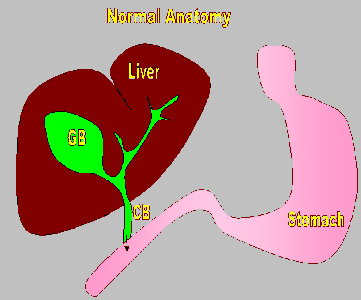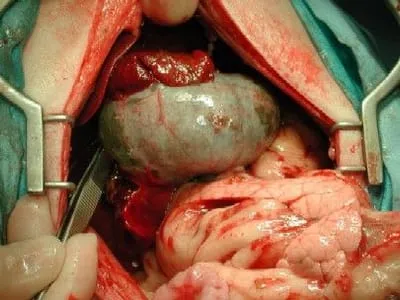Key Points
The gall bladder can be removed in dogs and a normal life span can be expected (as is the case in humans)
Early treatment of gall bladder disease results in the best prognosis
Because most cases are diagnosed late in the course of the disease, the survival rate following surgery is about 50%
Anatomy
- Bile is a yellow fluid, which contains chemicals that help digest fats, is produced by the liver and is transported to the gall bladder (labeled GB) via the bile ducts
- Once bile is in the gall bladder it removes some of the water in order to concentrate the bile, making it more potent to digest fats
- The common bile duct (labeled CB) delivers bile from the gall bladder to the intestine
- The gall bladder contracts in response to ingestion of a meal

Gall bladder removal
- The gall bladder can be removed in dogs and a normal life span can be expected (as is the case in humans)
- Fatty foods should be avoided in dogs that have the gall bladder removed
- Bile then flows from the bile ducts of the liver directly in to the small intestine via the common bile duct and is not as concentrated
- Indications to remove a gall bladder
- rupture of the gall bladder due to trauma or from obstruction of the common bile duct due to stones or congealed bile
- tumor of the gall bladder
- In the photo (right) the large green structure is a very distended gall bladder that needs to be removed

Illustration of a gallbaldder removal also known as a cholecystectomy:

Cholecystoduodenostomy
- This procedure involves dissecting the gall bladder off of the liver, making a hole in the gall bladder and sewing it to a hole made in the small intestine
- This allows bile to flow from the liver to gall bladder, then directly to the intestine – this is in essence a by-pass for bile so that it no longer needs to flow through the common bile duct
- Indications for cholecystoduodenostomy
- scarred or constricted common bile duct which does not allow bile to pass through to the intestine
- tumor of the common bile duct
- pancreatitis which causes the common bile duct to swell shut

Complications
- Usually these dogs and cats are very ill, thus are at high risk for death after surgery; the survival rate following either of the above surgeries is about 50%; if the pet survives the first 2 to 3 days after surgery, then the surgery is usually successful
- Liver infection
- Pancreatitis
- Stricture of the new opening made in the gall bladder, thus the pet becomes jaundiced again


